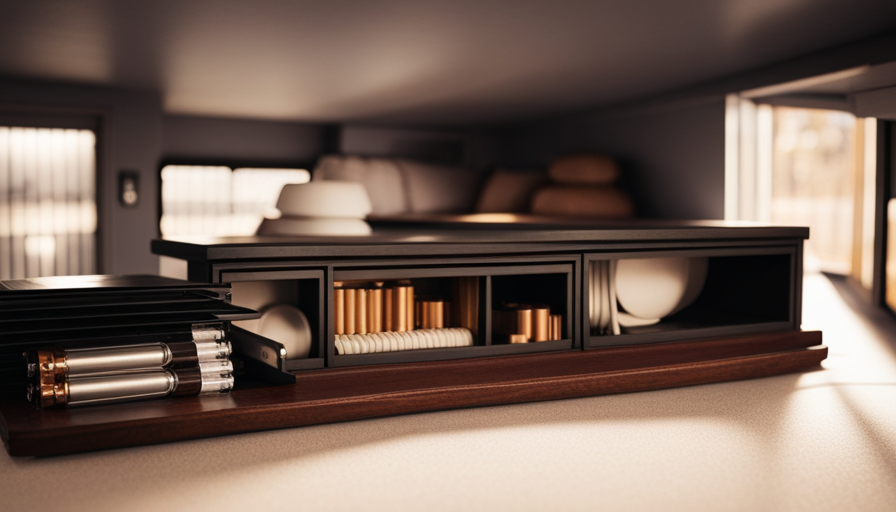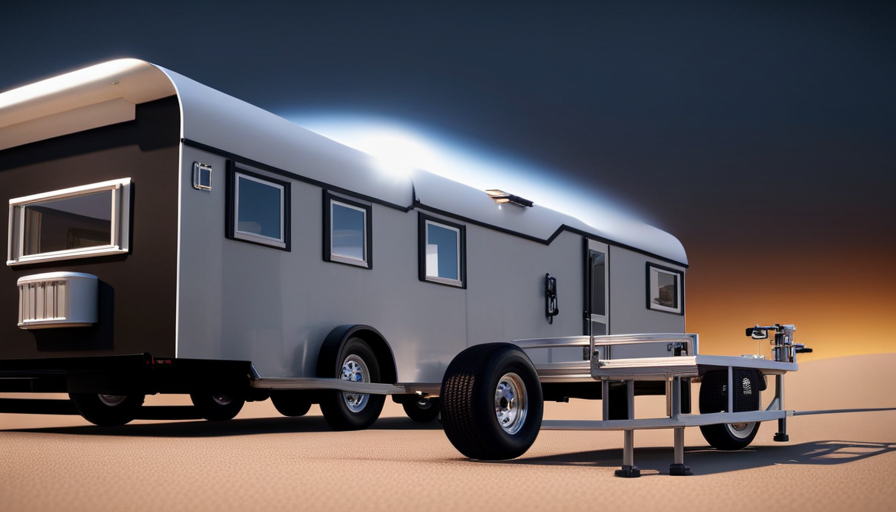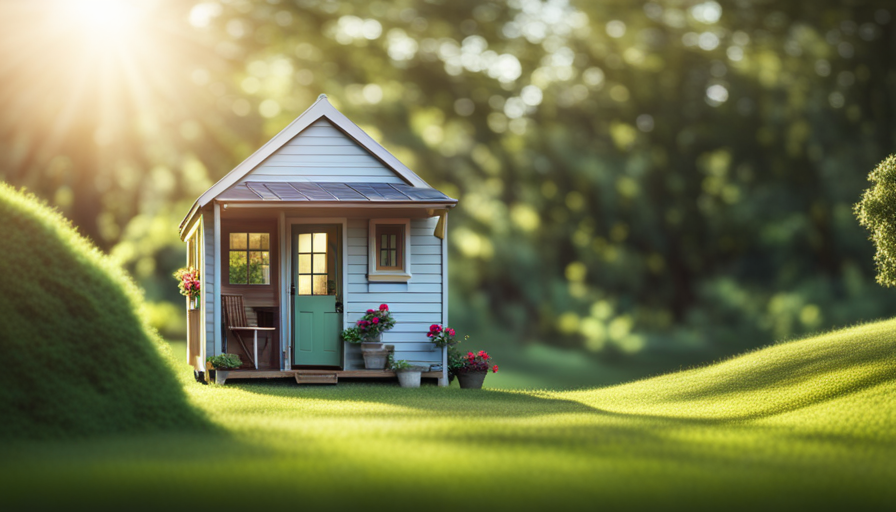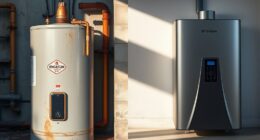Congratulations on your decision to embrace a minimalist lifestyle and become part of the tiny house community! But before you can truly enjoy the benefits of living small, there’s an important question you need to address: How many batteries do you need for your tiny house?
Ah, the irony of it all. In a world where everything seems to be getting bigger and more power-hungry, here we are discussing how to optimize energy consumption in our humble abodes. But fear not, fellow minimalists, for I am here to guide you through this technical and analytical journey.
In this article, we will delve into the nitty-gritty details of:
- Assessing your energy consumption needs
- Choosing the right battery type
- Calculating battery capacity requirements
- Considering alternative power sources
- Understanding charging and discharging rates
- Ensuring proper battery maintenance
- Investing in a battery monitoring system
- Embracing energy efficiency measures
- Seeking professional advice.
So grab your calculators and get ready to embark on an enlightening adventure into the world of batteries for your tiny house!
Key Takeaways
- Assess energy consumption needs and calculate daily energy consumption for a tiny house
- Consider alternative power sources such as solar panels and wind turbines to reduce dependence on traditional battery systems
- Proper battery maintenance is essential for longevity and performance, including regular inspections, maintaining electrolyte levels, and keeping batteries fully charged
- Use shorthand and concise bullet points to streamline the decision-making process and accurately estimate the number of batteries needed for a tiny house.
Assess Your Energy Consumption Needs
You’ll need to assess your energy consumption needs in order to determine how many batteries you’ll require for your tiny house. This step is crucial as it will help you understand the amount of power your appliances and devices consume on a daily basis.
Start by making a list of all the energy-saving appliances you plan to have in your tiny house, such as LED lights, energy-efficient refrigerators, and low-power electronics. These appliances can significantly reduce your overall power consumption.
Next, consider the off-grid power options available for your tiny house. Solar panels are a popular choice among tiny homeowners due to their renewable and sustainable nature. They can provide ample electricity during sunny days while charging the batteries for nighttime use. Wind turbines are another option if you live in an area with consistent wind patterns.
By assessing your energy consumption needs and understanding the off-grid power options available, you can determine how many batteries will be sufficient for your tiny house. This will ensure that you have enough stored energy to power all of your essential appliances and devices throughout the day and night without relying on external sources.
Now let’s move on to choosing the right battery type for optimal performance and longevity.
Choose the Right Battery Type
When choosing the right battery type for my tiny house, I need to compare different battery chemistries and consider factors such as lifespan and maintenance requirements.
It’s important to understand the differences between batteries like lead-acid, lithium-ion, and nickel-cadmium in terms of their energy density, cycle life, and cost.
Additionally, considering factors like how often I’ll be using the batteries and if they’ll need regular maintenance can help me make an informed decision on which battery type is best suited for my energy consumption needs.
Compare different battery chemistries
Lithium-ion batteries, like tiny energetic powerhouses, are a popular choice for small houses due to their high energy density and long lifespan. When comparing different battery chemistries for a tiny house, it’s important to consider factors such as battery cost and environmental impact.
Lithium-ion batteries may have a higher upfront cost compared to other types of batteries, but they make up for it with their superior performance and longevity. They have a longer cycle life and can withstand more charge-discharge cycles without deteriorating significantly. Additionally, lithium-ion batteries are known for their high energy density, meaning they can store more energy in a smaller package. This makes them ideal for small spaces like tiny houses where maximizing space is crucial.
Transitioning into the subsequent section about considering factors such as lifespan and maintenance requirements, it’s essential to evaluate these aspects thoroughly before making a decision on the right battery chemistry for your tiny house project.
Consider factors such as lifespan and maintenance requirements
It’s important to thoroughly evaluate lifespan and maintenance requirements before choosing the right battery chemistry for your compact dwelling. When considering lifespan, it is crucial to assess how long a battery can last before needing replacement. Some chemistries, like lithium-ion, have longer lifespans compared to lead-acid batteries. Additionally, maintenance requirements should be taken into account as they can vary between battery types. Lithium-ion batteries generally require less maintenance compared to lead-acid batteries, which may need regular water refilling and equalization charges. To help visualize the differences in lifespan and maintenance requirements, refer to the table below:
| Battery Chemistry | Lifespan Considerations | Maintenance Requirements |
|---|---|---|
| Lithium-ion | Longer lifespan | Less maintenance |
| Lead-acid | Shorter lifespan | More maintenance |
Considering these factors will ensure that you select a battery chemistry that meets your needs for longevity and ease of upkeep. Transitioning into the subsequent section about calculating the required battery capacity…
Calculate the Battery Capacity Needed
To figure out how many batteries you’ll need for your tiny house, just pretend you’re powering a spaceship and start stockpiling those power cells! Battery capacity estimation is an essential step in designing an off-grid power generation system. It involves calculating the amount of energy your tiny house will consume and determining the battery capacity required to meet that demand.
First, you need to determine your daily energy consumption. This can be done by identifying all the electrical appliances and devices in your tiny house and estimating their power usage. Once you have this information, multiply the total wattage by the number of hours each device will be used to get the daily energy consumption.
Next, consider factors such as weather conditions and seasonal variations in energy requirements. If you live in a location with harsh winters or experience frequent cloudy days, you may need to increase your battery capacity to ensure sufficient backup power during low sunlight periods.
Additionally, think about maintenance requirements when choosing battery technology. Some batteries require regular maintenance like checking water levels or equalizing charges, while others are maintenance-free.
By calculating your battery capacity needs accurately based on these factors, you can ensure a reliable power supply for your tiny house. Now that we have determined the necessary battery capacity, let’s consider alternative power sources for additional flexibility without relying solely on batteries.
Consider Alternative Power Sources
One option you can explore is incorporating solar panels or wind turbines to provide an alternative power source for your off-grid energy needs. These alternative power sources can supplement or even replace the need for batteries in your tiny house. Solar panels harness energy from the sun and convert it into electricity, while wind turbines use the power of the wind to generate electrical energy.
By utilizing these renewable energy sources, you can reduce your dependence on traditional battery systems. When considering alternative power sources, it is important to assess your energy consumption. Evaluate how much electricity you require on a daily basis and determine if solar panels or wind turbines can meet those needs consistently. Keep in mind that these alternative sources are dependent on weather conditions, so it may be necessary to have a backup battery system in place for times when there is limited sunlight or wind.
Understanding charging and discharging rates will be discussed in the subsequent section about ‘understand charging and discharging rates.’ This knowledge is crucial for optimizing battery performance and ensuring efficient utilization of alternative power sources.
Understand Charging and Discharging Rates
Understanding the charging and discharging rates is crucial for optimizing battery performance and ensuring efficient utilization of alternative power sources. Here are four key factors to consider when evaluating charging efficiency and battery lifespan:
-
Charging Rate: The speed at which a battery can be charged affects its overall efficiency. Rapid charging may result in higher energy losses due to heat dissipation, reducing the charging efficiency over time.
-
Discharging Rate: Similarly, the rate at which a battery is discharged impacts its performance. High discharge rates can lead to voltage drops and decreased capacity, affecting both the functionality and lifespan of the battery.
-
Depth of Discharge: It is essential to understand how deeply a battery can be discharged before recharging it. Excessive depth of discharge can accelerate wear and tear on batteries, ultimately shortening their lifespan.
-
Temperature Effects: Extreme temperatures impact battery performance significantly. High temperatures increase self-discharge rates, while low temperatures reduce overall capacity.
By considering these factors, you can plan for an optimal battery bank sizing that meets your tiny house’s energy requirements without compromising longevity or efficiency.
Transitioning into the subsequent section about planning for battery bank sizing, it is important to assess these aspects carefully to ensure a reliable power supply for your tiny home needs.
Plan for Battery Bank Sizing
Consider how you can efficiently size your battery bank to meet the power needs of your compact living space while maximizing longevity and performance. Calculating the appropriate battery bank size is crucial for ensuring a reliable and sustainable power supply in your tiny house.
To determine the battery capacity needed, you must first estimate your daily energy consumption. This involves assessing the power requirements of all your appliances, lighting, and other electrical devices, as well as accounting for any planned expansions or future additions.
Once you have an idea of your daily energy consumption, you can move on to calculating the battery capacity required. The formula for this calculation is relatively simple: divide your estimated daily energy consumption by the depth of discharge (DOD) percentage and multiply it by the number of days’ worth of backup power desired. The DOD represents the amount of usable energy that can be extracted from a fully charged battery before recharging becomes necessary.
After determining the required battery capacity, you need to consider other factors such as efficiency losses due to temperature fluctuations and system inefficiencies when choosing specific batteries for your bank. Additionally, it’s essential to ensure proper battery maintenance to prolong their lifespan and maintain their performance.
By accurately sizing your battery bank based on careful calculations and estimations, you can provide sufficient power while optimizing longevity and performance in your tiny house setup. Properly maintaining these batteries will further enhance their reliability and durability in meeting your power needs without compromising efficiency or functionality.
Ensure Proper Battery Maintenance
To ensure your battery bank remains efficient and reliable over time, it’s crucial that you diligently maintain them, treating them like the lifeblood of your power supply. Battery maintenance is essential for maximizing their lifespan and preventing common issues that can arise.
Here are some battery maintenance tips to keep in mind:
-
Regularly check the electrolyte levels: Monitoring the electrolyte levels in your batteries is important because low levels can lead to decreased performance. Add distilled water if necessary.
-
Clean the terminals: Dirty terminals can hinder proper charging and discharging of batteries. Use a wire brush to remove any corrosion or buildup on the terminals.
-
Keep batteries fully charged: Avoid deep discharges by regularly recharging your batteries to their full capacity. This helps prevent sulfation, which can decrease battery efficiency.
-
Store batteries properly: If you’re not using your tiny house for an extended period, make sure to disconnect and store the batteries in a cool and dry place.
-
Perform regular inspections: Check for any signs of damage or leaks in your battery bank. Addressing these issues promptly can prevent further damage.
By following these battery maintenance tips, you can troubleshoot common battery issues and ensure optimal performance for years to come. Investing in a battery monitoring system will provide additional insights into their health and assist with proactive management.
Invest in a Battery Monitoring System
Investing in a battery monitoring system will enhance your ability to effectively manage and maintain the performance of your power supply over time. Battery capacity optimization is crucial for maximizing the efficiency and lifespan of your batteries, especially in a tiny house where space is limited.
With a battery monitoring system, you can closely track the state of charge, discharge rates, and overall health of your batteries. This technology provides real-time data that allows you to identify any potential issues or abnormalities early on.
A battery monitoring system also ensures that you’re getting the most out of your batteries by optimizing their capacity. By closely monitoring their performance, you can adjust charging and discharging patterns to avoid excessive strain on the batteries and prevent premature degradation. This will ultimately extend their lifespan and save you money in replacement costs.
Furthermore, a battery monitoring system provides valuable insights into energy usage patterns within your tiny house. By analyzing this data, you can identify areas where energy efficiency measures can be implemented to reduce overall power consumption. Transitioning into the subsequent section about ‘consider energy efficiency measures,’ it’s important to take advantage of this information to further optimize your power supply and minimize waste.
Consider Energy Efficiency Measures
Are there ways to make your energy consumption more efficient in order to maximize the lifespan of your power supply? Absolutely! By incorporating energy efficiency measures into your tiny house, you can reduce the amount of electricity you require and ultimately extend the life of your batteries. One effective way to achieve this is by investing in energy-saving appliances. These appliances are specifically designed to use less power without compromising on performance, making them ideal for off-grid living. Additionally, implementing insulation techniques such as using double-glazed windows, insulating walls and floors, and sealing any air leaks can greatly reduce heat loss or gain, resulting in lower energy demands.
To further emphasize the significance of energy efficiency measures, let’s take a look at this emotion-evoking table:
| Energy Efficiency Measure | Benefits |
|---|---|
| Energy-saving appliances | Lower electricity bills |
| Insulation techniques | Enhanced comfort levels |
| Reduced environmental impact | Decreased carbon footprint |
By embracing these measures, not only will you save money on electricity bills but also enjoy improved living conditions while minimizing your ecological footprint.
Considering these energy-saving strategies is essential when planning for a tiny house battery setup. Seeking professional advice will help you optimize your approach and ensure that you create an efficient and sustainable power system for your tiny home.
Seek Professional Advice
Now that we’ve explored various energy efficiency measures for a tiny house, it’s crucial to seek professional advice before making any decisions regarding the number of batteries required. Seeking professional guidance ensures that you make informed choices and optimize the battery installation process.
When it comes to determining how many batteries your tiny house needs, consulting with an expert in the field is highly recommended. They possess the knowledge and experience to assess your specific energy requirements and provide accurate recommendations tailored to your unique situation.
Here are four reasons why seeking professional advice is essential:
-
Expertise: Professionals have a deep understanding of battery systems and can guide you towards the most suitable options for your tiny house.
-
Optimal Performance: With their expertise, professionals can help you choose batteries that’ll maximize energy storage and usage efficiency.
-
Cost-Effectiveness: By seeking professional advice, you can avoid overspending on unnecessary batteries or undersizing your system, saving both money and resources.
-
Safety: Proper installation of batteries is crucial for safety reasons, and professionals can ensure that all electrical connections are made correctly.
By engaging with professionals who specialize in battery installations for tiny houses, you can make well-informed decisions about the number of batteries needed while ensuring a smooth installation process.
Frequently Asked Questions
Can I use the same type of batteries for all my energy needs in a tiny house?
Yes, it’s possible to use the same type of batteries for all energy needs in a tiny house. However, using different types of batteries for different energy needs can be more efficient and cost-effective.
By matching specific battery types to each energy requirement, such as deep-cycle batteries for long-term storage and lithium-ion batteries for high-power applications, you can optimize performance and extend battery life.
Using a single type of battery may lead to potential risks like limited capacity or inadequate power supply for certain devices or appliances.
What are some alternative power sources that can be used in conjunction with batteries for a tiny house?
What alternative power sources can be used with batteries in a tiny house?
Are solar panels and wind turbines viable options?
Solar panels harness the energy of the sun and convert it into electricity, which can then be stored in batteries for later use.
Wind turbines, on the other hand, generate electricity by converting the kinetic energy of the wind into electrical energy.
Both these sources can supplement battery power and provide sustainable energy for a tiny house.
How often do I need to replace the batteries in my tiny house?
Batteries in a tiny house typically last around 4-8 years, depending on usage and maintenance. To extend their lifespan, proper care is crucial. Regularly check battery levels and ensure they’re not overcharged or discharged deeply. Using a Battery Management System can help optimize performance.
Signs indicating the need for replacement include reduced capacity, frequent low voltage warnings, longer charging times, and increased self-discharge rates. It’s important to monitor these factors to maintain an efficient power system.
What are some energy efficiency measures that can be implemented to reduce battery usage in a tiny house?
To reduce battery usage in a tiny house, implementing energy efficiency measures is crucial. One effective way is to invest in energy-efficient appliances that consume less power.
Additionally, installing solar panels can greatly decrease the reliance on batteries by generating renewable electricity.
By optimizing appliance usage and harnessing solar energy, the need for frequent battery replacements can be minimized, resulting in long-term cost savings and environmental benefits.
How do I properly dispose of old or damaged batteries from my tiny house?
To properly dispose of old or damaged batteries from my tiny house, I should consider battery recycling. It’s essential to handle these batteries with care due to their potential environmental impact. Battery recycling centers are equipped to safely collect and process various types of batteries, ensuring that harmful substances are disposed of correctly.
By utilizing battery recycling services, I can contribute to reducing pollution and protecting the environment from the negative effects of improper battery disposal.
Conclusion
In conclusion, when it comes to determining how many batteries are needed for a tiny house, it’s crucial to assess your energy consumption needs and choose the right battery type. By calculating the battery capacity required and considering alternative power sources, you can ensure uninterrupted power supply.
Understanding charging and discharging rates, as well as proper battery maintenance, is essential for maximizing battery lifespan. Investing in a battery monitoring system and implementing energy efficiency measures will further optimize energy usage.
Seeking professional advice can provide valuable insights tailored to your specific requirements. Remember, every watt counts!
Hi, I’m Emma. I’m the Editor in Chief of Tiny House 43, a blog all about tiny houses. While tree houses are often associated with childhood, they can be the perfect adult retreat. They offer a cozy space to relax and unwind, surrounded by nature. And since they’re typically built on stilts or raised platforms, they offer stunning views that traditional homes simply can’t match. If you’re looking for a unique and romantic getaway, a tree house tiny house might just be the perfect option.










